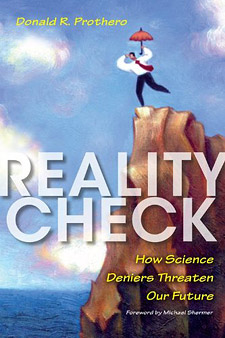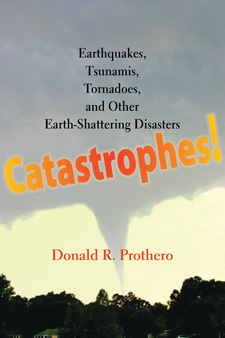by
Donald Prothero, Sep 06 2014
In recent months, we’ve heard a number of prominent people (from Michael Shermer to Neil DeGrasse Tyson) say that there’s no real difference between the political parties when it comes to science denial. According to this argument, there is bad thinking and “woo” on both sides of the political spectrum. To counteract the fact that science deniers like creationists and climate deniers are overwhelmingly Republican, they point to other types of “woo” like anti-vaxxers, anti-GMOs, anti-frackers, and the like, and claim that these are largely found on the left wing. It turns out, however, that contrary to myth, anti-vaxxers tend to be more right-wing than left-wing (especially among the people who fear government, the large religious crowd that rejects modern medicine, and the home schoolers who don’t want to let their kids be vaccinated).
For example, in his 2012 book The Republican Brain: The Science of Why they Deny Science—And Reality, Chris Mooney admits that not all examples of science denial are on the right wing. There are certain ideas, such as the fears of nuclear power, or of scary oil company practices like fracking, that are predominately held by liberals and environmentalists. But there are important differences here. Adherence to pseudoscience and anti-science is not symmetrically distributed between the left and the right. Ideas such as anti-vaxx, anti-nukes, and anti-fracking are not held uniformly by the majority of liberals or progressives, but only a tiny subset, whereas studies show that the ideas of creationism and global climate change denial are virtually universal among American conservatives now. Continue reading…
comments (15)
by
Donald Prothero, Nov 13 2013
In my new book Reality Check, I described research by a number of authors who investigated and exposed the 50-year-long effort by the tobacco companies to deny that they made a product that was dangerous. They did all they could to obfuscate and delay public health action by the well-known tactic of “smokescreens” to hide their real action. As the famous quote by the PR firm Hill & Knowlton (hired in the 1950s to advise Big Tobacco) said, “Doubt is our product since it is the best means of competing with the ‘body of fact’ that exists in the minds of the general public. It is also the means of establishing a controversy.” For the next fifty years, the tobacco companies pursued this strategy. They paid for research by their own scientists, and suppressed or censored the results if they showed that tobacco was dangerous, but vigorously promoted any results that seemed favorable to them. They waged an all-out campaign to harass and impugn the research by outside scientists who discovered that tobacco was dangerous. They played the classic game of “doubt” mongers everywhere: insist on absolute scientific “certainty”, so that if the results are overwhelming (say, 80-90% certain), they would argue that it’s not good enough. (This, of course, plays on the public misconception about science, which is always about statistical likelihood, and rarely deals in true “certainty”). They hired prominent scientists in totally unrelated fields like nuclear physics to be their spokesmen, and to fight their battles in the public arena, especially in the halls of Congress. These people often played the “other causes” fallacy: if a disease like lung cancer can occur because of multiple causes, the tobacco companies would focus on these minor “other causes,” and insist that nothing should be done about regulating their own industry—even though all the independent research clearly showed that smoking was by far the most important cause of lung, throat, mouth, and other cancers. They fought their opponents vigorously with lawsuits and armies of lawyers, and battled tooth and nail to never lose a lawsuit against them—because one admission that they were responsible for someone’s death due to smoking would unleash an avalanche of lawsuits against them. Above all, they waged a relentless PR campaign to make tobacco seem safe and glamorous, or minimize its dangers, even as the weight of scientific evidence and public opinion was becoming overwhelmingly against them. Continue reading…
comments (29)
by
Donald Prothero, Mar 21 2012
The recent passing of Sherwood Rowland, who won the 1995 Nobel Prize in Chemistry for his discovery (along with Mario Molina and Paul Crutzen) that CFCs (chlorofluorocarbons) break down ozone in the stratosphere, causes me to think back on that furious debate over environmental issues—and the remarkable way it was resolved by international agreement and no longer threatens us. Those of us who are old enough to remember the political events of the 1970s and 1980s might recall the big public concern over the ozone layer. Like the debate over acid rain, this environmental crisis arose from earlier research that suggested a problem, then ran into huge opposition from conservative business and anti-environmental interests during the 1980s when Reagan’s cronies were in power. Like the debate over acid rain, the evidence for the hole in the ozone layer only increased until the pressure from scientists and governments around the world overcame the resistance of the affected industries, and resulted in an eventual global agreement to curb the causes of this pollution.
The story began in the late 1960s when the U.S. and Europe were both engaged in a race to develop a supersonic transport (SST) for civilian passengers, which would whisk people around huge distances in much shorter times (primarily between Europe and America). I vividly remember this series of events, because my father worked for Lockheed Aircraft at the time, and spent years of his life working very long hours to develop a huge multivolume “proposal” for how the Lockheed SST would be built. Huge numbers of man-hours and millions of dollars building two working prototype aircraft were wasted by Lockheed in the competition when the contract went to Boeing Aircraft instead. Ironically, the Boeing SST was eventually canceled, too. The only SST that was built was the Anglo-French Concorde, which traveled between New York and Paris from 1976 until it was retired in 2003 due to low demand after the 2000 Concorde crash, low air traffic after 9/11, and high costs since most of the electronics in the aircraft were over 30 years old and obsolete. Continue reading…
comments (32)
by
Donald Prothero, Dec 14 2011
I have written frequently in these blogposts about the numerous forms of denial of science and reality that are out there, from global warming denialism, to AIDS denialism, anti-vaxxers, and creationism. They all have a lot in common, from their insular exclusionary attitude that refuses to accept evidence that doesn’t fit their world view, to the various strategies they use to reduce cognitive dissonance and fight against reality, all borrowed from the Holocaust deniers. These include: quoting out of context (“quote-mining”) to dishonestly suggest that the quoted person agrees with them, cherry-picking data to show the exact opposite of what the data really show, making phony lists of “experts” who agree with them, picking on the small differences within the scientific community as evidence that the “science is not settled”, picking on one small factoid (usually misinterpreted and out of context) as evidence that the whole of science is false, and so on. Usually, these obvious strategies to deny an overwhelming body of evidence are so transparently self-delusional that we can laugh at them.
 But then I ran into something that staggered even my sense of how low these people can go. We are all familiar with how creationists use ad hoc explanations and special pleading to rescue the absurdities of their world view, from trying to cram all of the animals into Noah’s ark and dismissing the huge numbers problem through their non-biological concept of “created kinds”, to doing all sorts of violence to the geologic record to justify the Noah’s flood story, to even insisting that men have one less rib than do women (the last one is easy to check, but they don’t). As I have discussed in several previous posts, the more extreme Biblical literalists also believe in a flat earth and reject the heliocentric solar system. But I was flabbergasted to read of a whole group of extreme creationists who deny that dinosaurs existed! Usually, the creationists not only come to terms with the evidence of dinosaurs, but many have even tried to co-opt their popularity with kids under 10 by making them a prominent part of their propaganda (as does Ken Ham of the “Answers in Genesis” ministry and the “Creation Museum” in Petersburg, Kentucky). With something as widely accepted and exciting and popular as dinosaurs, which anyone can see for themselves in their local museum, how could any person in the 21st century argue they are not real?
But then I ran into something that staggered even my sense of how low these people can go. We are all familiar with how creationists use ad hoc explanations and special pleading to rescue the absurdities of their world view, from trying to cram all of the animals into Noah’s ark and dismissing the huge numbers problem through their non-biological concept of “created kinds”, to doing all sorts of violence to the geologic record to justify the Noah’s flood story, to even insisting that men have one less rib than do women (the last one is easy to check, but they don’t). As I have discussed in several previous posts, the more extreme Biblical literalists also believe in a flat earth and reject the heliocentric solar system. But I was flabbergasted to read of a whole group of extreme creationists who deny that dinosaurs existed! Usually, the creationists not only come to terms with the evidence of dinosaurs, but many have even tried to co-opt their popularity with kids under 10 by making them a prominent part of their propaganda (as does Ken Ham of the “Answers in Genesis” ministry and the “Creation Museum” in Petersburg, Kentucky). With something as widely accepted and exciting and popular as dinosaurs, which anyone can see for themselves in their local museum, how could any person in the 21st century argue they are not real?
Continue reading…
comments (56)
by
Donald Prothero, Oct 05 2011
Reality must take precedence over public relations, for Nature cannot be fooled.
—Richard Feynman
To treat your facts with imagination is one thing, but to imagine your facts is another.
—John Burroughs
Reality is that which, when you stop believing in it, doesn’t go away.
—Philip K. Dick, author
You are entitled to your own opinion, but you are not entitled to your own facts.
—Former Sen. Daniel Patrick Moynihan, 2003
What’s real is what’s real, and, like it or not, no one can change the nature of reality. Except, of course, with mushrooms.
—Bill Maher
It happens so often that we are inured and desensitized to it. Creationists spout lies and distortions about science and reality, and no one disputes them (except an occasional high school student who challenged Michele Bachmann’s assertion that Nobelists denied evolution). Politicians like Rick Perry and Bachmann get up and brag about their doubts about the reality of global climate change and evolution, and they become the darlings of the GOP. Partisan media like Fox News and their parent company NewsCorp admit that they are receiving money from GOP candidates, or funneling it to them, and no one seems to care. News Corp and Rupert Murdoch get away with all sorts of outrages in their tabloids, yet they are so powerful that British politicians and cops dare not cross them—until their actions are so extreme that all of the UK is disgusted with them. But every once in a while, the cat is let out of the bag, and someone says something that reveals how these people are either abysmally ignorant of reality because of deluded ideology, or they are smart enough to recognize it but play along in a cynical grab for power over those who are ignorant or ill informed.
The latest incident occurred when two pundits on Fox News were discussing the GOP candidates. They point to Jon Huntsman as the sole candidate who would admit that global warming is real (Romney, Gingrich, and others who also once admitted it are now backtracking to kowtow to the extremists who vote in GOP primaries and caucuses). They comment that he’s losing ground to Rick Perry, who made false claims not only about global warming but also about how scientists were allegedly committing fraud. One of the Fox anchors, Clayton Morris, says it it in no uncertain terms:
Certainly, if you dive into the weeds a little bit on this global warming thing, you see that it seems the facts are certainly on Huntsman’s side on all of this and fact checkers have come out, and we’re actually having our own brain room look at this right now, that any of Perry’s comments don’t seem to hold a lot of water. But it doesn’t matter, because what’s resonating right now in South Carolina is helping Governor Perry tremendously. He fired back at Huntsman on global warming and gaining traction, facts or not.
Continue reading…
comments (66)
by
Donald Prothero, Aug 24 2011
Last week I returned from an amazing Skeptic Society cruise along Alaska’s Inside Passage. During the cruise, we held a conference with 200 other Skeptics on “Glaciers and the Science of Climate Change,” with presentations by scientific experts on glaciers and climate. On day 3, we witnessed the glaciers melting away before our very eyes. At Glacier Bay National Park, we saw tons of ice calving away from Margerie and Johns Hopkins glaciers, causing huge booms to echo across the fjord. As our resident expert Dr. Bruce Molnia of the USGS pointed out during his presentation, over 95% of the glaciers of Alaska are stagnant or shrinking, and we saw several examples of these. Molnia has been studying Alaska’s glaciers for decades, and he showed stunning images of how much they have retreated in just the past century (such as the images of the retreat of Muir Glacier below, shot in 1941 and in 2004). If you recall the images of the vanished glacier’s in An Inconvenient Truth, some of those were from Molnia’s research. We billed the trip as “See ‘em before they vanish” but in the case of most of the glaciers, it’s already too late. If my 6- and 8-year-old sons repeat this trip decades later as grown men, there will be almost no glaciers to see at all.

Naturally, the conference focused on the scientific evidence about glacier retreat and global climate change. Our moderator Michael Shermer challenged us to show us the evidence that climate change is real and anthropogenic, and our speakers did so in spades. Much of this evidence was outlined in Chapter 10 of my new book Catatastrophes!, so I will not repeat all of it here. But some of the key points that came up again and again in the conference were:
Continue reading…
comments (97)
by
Donald Prothero, Jul 20 2011
I’ve just survived four days of The Amazing Meeting 9 in Las Vegas, and my head is buzzing with so many thoughts—so many great talks—so many friends I haven’t seen since TAM8 last year, and new ones I met for the first time after months of email and Facebook exchanges. TAM never fails to exhilarate me—and exhaust me. My favorites: Bill Nye’s brilliant pep talk for science and space exploration; Dawkins’ wonderful preview of his new book and his speculations about extraterrestrial life; PZ Myers’ very different take on the non-prevalence of humanoids on other planets; Elizabeth Loftus’ succinct review of her lifetime of research showing the unreliability of human memory; and especially the message at the end of both Neil DeGrasse Tyson’s and Sean Faircloth’s presentations: we need to dial back all the petty sniping within our ranks and realize that we face a very serious enemy out there of religious and political zealots who do not value science, skepticism, critical thinking, or “reality-based” political views. They outnumber us; they are well funded by right-wing think tanks and evangelical churches; and they have elected plenty of people in power who are already pushing their agenda. I realize that getting skeptics and freethinkers to work together is like herding cats, but we have a powerful entrenched opposition that will require every resource at our disposal to hold them at bay, let alone push them back. They are already eroding science education and displacing good science with pseudoscience in public policies.

But my favorite talk was Eugenie Scott’s presentation, “Deja Vu all over again: Denialism of Climate Change and Evolution.” It gave me a sense of deja vu, because apparently without knowledge of each others’ work, we have converged on a common topic. This is what philosopher William Whewell would call a “consilience” or common agreement of different lines of evidence or threads of argument. As I independently pointed out in my upcoming book written last summer about science denialism, entitled Reality Check, and in a paper I wrote which is now in press, there are tremendous parallels between the evolution-deniers (creationists), the climate change deniers, and many other types of science deniers. Even more striking, they borrow most of their tactics from the prototypical reality deniers, the Holocaust revisionists, along with the tactics of the tobacco companies in creating “doubt” through PR to obscure the real science.
Continue reading…
comments (44)






